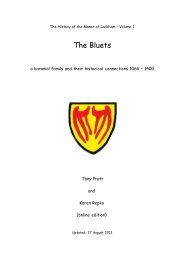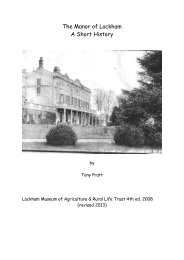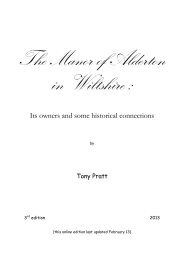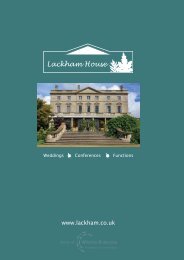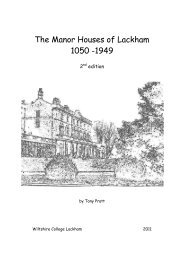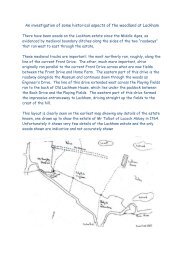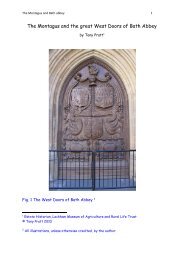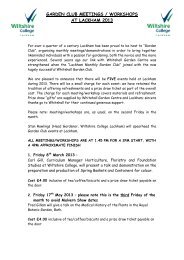History of Agricultural Education in Wiltshire - Lackham Countryside ...
History of Agricultural Education in Wiltshire - Lackham Countryside ...
History of Agricultural Education in Wiltshire - Lackham Countryside ...
Create successful ePaper yourself
Turn your PDF publications into a flip-book with our unique Google optimized e-Paper software.
Despite their limitations, the clubs had much <strong>in</strong> their favour and a foundation was<br />
laid for further development <strong>of</strong> the movement <strong>in</strong> the years ahead.<br />
Soon after the outbreak <strong>of</strong> war <strong>in</strong> 1939, club membership dropped severely to a<br />
mere 7000 <strong>in</strong> England and Wales. In <strong>Wiltshire</strong> Mr McLees and his colleagues were<br />
transferred from <strong>Agricultural</strong> <strong>Education</strong> to the <strong>Wiltshire</strong> War <strong>Agricultural</strong><br />
Committee and travell<strong>in</strong>g <strong>in</strong> cont<strong>in</strong>uous blackouts, shortage <strong>of</strong> petrol and feed<strong>in</strong>g<br />
stuffs etc. all contributed to the many difficulties which caused several clubs to<br />
close down for the duration.<br />
In November 1939, the Government realised that Voluntary Youth Organisations<br />
could play an important part <strong>in</strong> the war effort if given the <strong>in</strong>centive and soon with<br />
f<strong>in</strong>ancial aid the N.F.Y.F.C. appo<strong>in</strong>ted thirty full-time and part—time organisers<br />
throughout England and Wales to extend the Y.F.C. activities and became an<br />
<strong>in</strong>tegral part <strong>of</strong> the service <strong>of</strong> youth <strong>in</strong> the countryside. This meant that the doors<br />
were opened wide and membership was no longer limited to the sons and. daughters<br />
<strong>of</strong> farmers, but to all young people <strong>in</strong>terested <strong>in</strong> rural life. A remarkable surge<br />
forward took place and by 1946, the number <strong>of</strong> clubs had risen to 1282 with a<br />
membership <strong>of</strong> 65,500 throughout the country.<br />
By 1942, the movement had recovered from its set back imposed by war conditions<br />
and the <strong>Wiltshire</strong> County Federation <strong>of</strong> Young Farmers' Clubs was reformed.<br />
President: The Earl <strong>of</strong> Radnor<br />
Chairman: Mr 0 M Peall<br />
Secretary: Mr L D C McLees<br />
Treasurer: Mr W E Beedel<br />
Lloyds Bank, Devizes<br />
Part-time Organiser for N.F.Y.F.C. Mr J 0 Thomas<br />
Dauntseys School<br />
Dur<strong>in</strong>g this time <strong>Agricultural</strong> <strong>Education</strong> <strong>in</strong> the form <strong>of</strong> teach<strong>in</strong>g and courses was<br />
curtailed and <strong>of</strong>ficers who had assisted Young Farmers' Clubs <strong>in</strong> the past were<br />
seconded to the newly formed War <strong>Agricultural</strong> Committees. Many Clubs closed<br />
down for the duration and by 1940, the membership throughout the country had<br />
dropped severely to a mere 7000.<br />
'<br />
Practically all the County Federations are now affiliated to the National<br />
Federation. The County Federations are represented on the Council and Anual<br />
General Meet<strong>in</strong>gs are held when resolutions from the various Clubs are debated<br />
and voted upon if necessary. The Council are responsible for the general direction<br />
:



